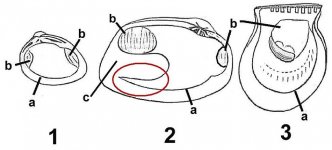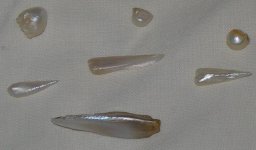"Different locations in the shell form the variety of shapes. Those along the lip are round and the largest ones are the rarest. Wing shaped pearls form along the back of the shell, and irregular or "baroque" pearls form in the heel of the shell. The brighter the luster, the more valuable it makes the pearl."
No and yes.
Pearls near the edge of the shell are smaller. That's because it's newer growth and lesser space. It's true that pearls form along the dorsal ridge within the pallial cavity, but shapes are varied.
I have attached a drawing of three orders of mollusk. Albeit crude and not necessarily to scale.

1- Clam (Heterodonta)
2- Mussel (Pteriomorph)
2- Pearl Oyster (Pterioid)
a - Pallial line
b- Adductor muscle
c- Pallial sinus
In every bivalve mollusk, the mantle has a point of attachment to the shell. This by the edges of the adductor muscle, then following the pallial line enclosing a circular pattern.
Clams have equal sized adductors, both anterior and posterior. In mussels, the anterior muscle is reduced in size, while the posterior adductor is exaggerated. Pearl oysters have a singular, large adductor.
This is an excellent example of evolution, as pearl oysters more advanced than clams. In that evolution, the pallial line is reduced. In the pearl oyster, the pallial line is less than half the diameter of the shell, while in the clam it's greater than half. In mussels, that process is incomplete, where the pallial line is greater in some areas, lesser in others. The term "pteriomorphia", means mussels are changing to become closer to their pearl oyster "pterioda" cousins. This creates appendix-like pockets where pearls conform to the surrounding tissues and spaces.
I have outlined in red, the area adjacent to the pallial sinus, where varied angles mark the pallial line. In saltwater mussels, this transition is more advanced than freshwater, hence the sharp angles and appendix pockets are reduced.
Therefore, it's reasonable to suggest "wing" pearls are common in freshwater mussels, uncommon in saltwater mussels and rare in pearl oysters.
...)

